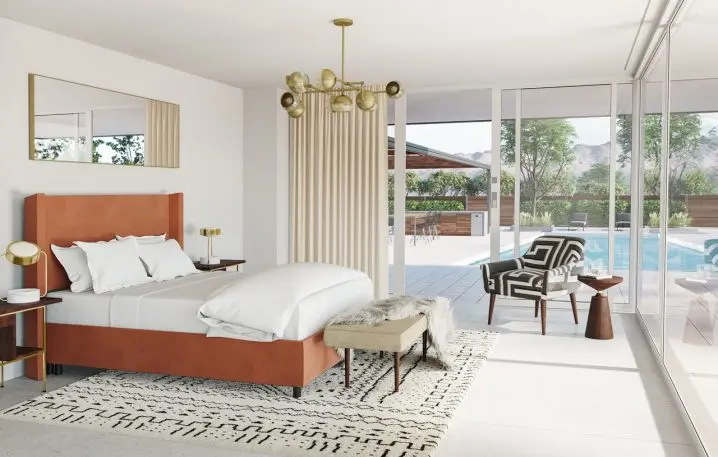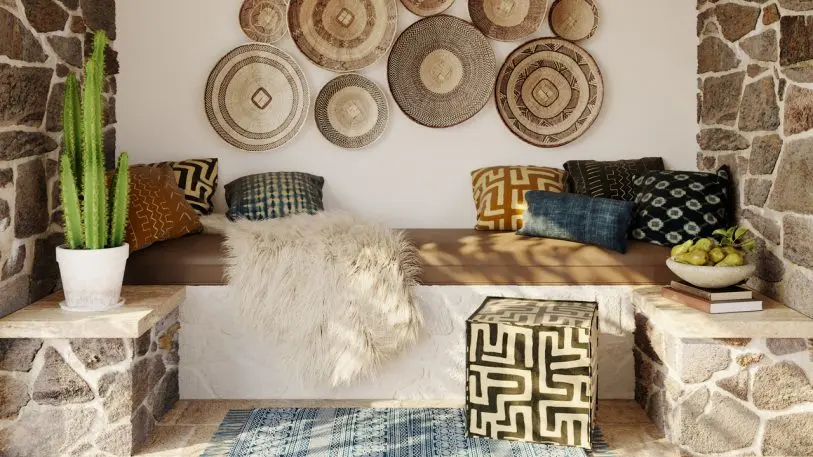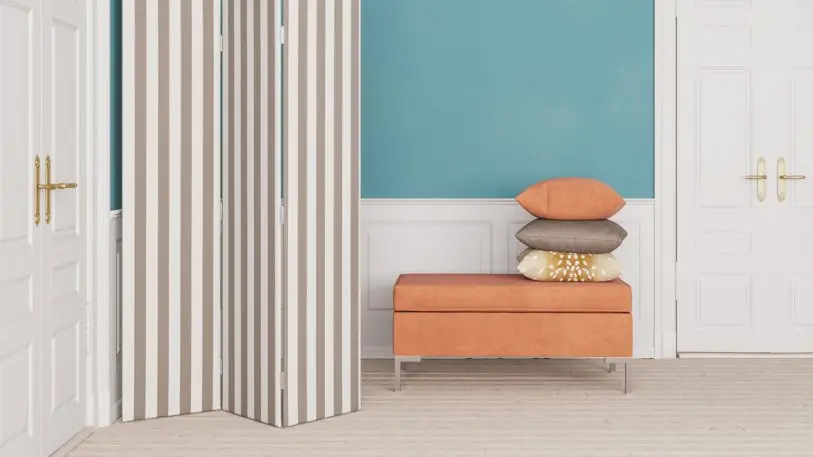Scanning through The Inside, the furniture startup cofounded by DwellStudio’s founder Christiane Lemieux, you’ll see patterns created by fashion designer Clare Vivier, whose brand is called Clare V. Vivier is known for her bright, colorful patterns, and her handbags are all the rage among chic New Yorkers and Angelenos. But thanks to The Inside’s direct-to-consumer approach, you can now get a Clare V. armchair for $299, less than than most bags in her collection.

Of course, interior design and furniture have always been influenced by trends in the fashion industry, but with the advent of social media, Lemieux believes that today’s millennial consumers are treating their homes much more like their closets, constantly bringing in new styles and updating their look. After all, homes are increasingly the backdrop to selfies and carefully art-directed Instagram posts.
Lemieux, who is now the CEO, and Bunn, who is COO, believe that the $150 billion home furnishings market is ripe for a brand that can deliver customized products quickly and affordably to this millennial consumer. Right now, millennials make up 66% of first-time home buyers, and they are 34% of all home buyers. And 66% plan to purchase a new home within the next five years. Research also shows that this generation spends $1,500 on their living rooms alone, which is more than previous generations spent when they were at this stage in their lives. “In the past, there was this sense that you would decorate your home and be done,” Lemieux tells me. “But to the modern consumer, the home is never finished: It’s always a work in progress. We are constantly changing the way it looks, rearranging the furniture, bringing in new pieces, changing the colors of our walls.”
With this new startup, launched out of beta earlier this summer, Lemieux has created a brand designed to accommodate how we live today. All of the products within the collection–from armchairs to bed frames to wallpaper–are customizable and made on demand. This means that you can purchase an armchair in the exact color or pattern you want, to match the style of your room, rather than searching for weeks for a piece that will fit in. The wallpaper can be easily applied then pulled off again. And every piece is delivered within two to three weeks, since The Inside makes all of its products in factories in North Carolina, Illinois, and Pennsylvania that ship directly to the customer. With most custom furniture brands, the wait is typically several months.

Today, The Inside announces that it has raised $2.6 million in seed funding, led by Corigin Ventures and Lerer Hippeau, with investments from Forerunner Ventures, Rent the Runway’s cofounder Jenny Fleiss and Apartment Therapy’s founder Maxwell Ryan. The company says it will use this infusion of cash to grow the team (which currently only consists of five employees), reach new customers, expand into new product categories, and invest further in visualization technology that brings products to life on the website.

A Clever Business Model
Part of the genius of The Inside’s business model is that it does not need to spend a lot of money stocking a warehouse with goods that may or may not be purchased, since every piece is made on demand for the customer. Most companies incorporate the cost of unsold goods into the final list price of their products, but since The Inside has no wasted inventory, it can sell products at lower prices than comparable brands. A throw pillow costs $39, a screen room divider costs $249, and all armchairs cost between $299 and $399. These are prices that are much more in line with Target and Ikea than with other made-to-order furniture brands like Interior Define and Burrow. They are also less expensive than brands like West Elm and Crate and Barrel. “We were focused on giving the customer very good value for money,” says Lemieux. “This makes it possible for them to update their rooms every so often by bringing in a new armchair or bench.”

Selling furniture and home goods at a low price point typically comes with trade-offs. To sell products at rock bottom prices, many brands have to manufacture in factories in China with inconsistent quality control, a problem that has been well-documented. With The Inside, Lemieux wants to make higher-quality, American-made furniture available at an affordable price.
Giving The Customer What They Want–Within Reason
The other crucial piece of The Inside’s value proposition is customization. A slew of startups, like Maiden Home and Interior Define, allow you to pick the piece of furniture you want, then pick the color of the wood and the fabric, before shipping it to you within a few weeks. Mainstream brands, such as Pottery Barn, have also been introducing a few affordable customizable pieces into their collections, although they often take several months to manufacture. The Inside stands out from competitors because it sells products for less money, and delivers them faster.
Technology is key. Back in 2016, Lemieux launched a business, called Cloth & Company, that was a precursor to The Inside. Cloth & Company deployed 3D imaging and printing technology to create fabrics on-demand in whatever color or pattern the customer chooses. With The Inside, Lemieux is leveraging this infrastructure to make customized products at scale. Rather than having an infinite number of fabric options, The Inside curates a selection of patterns and solid colors, which the customer can pick from. This means that the fabric-making factory already has a selection of patterns in the system, and can print them quickly. This is different from many other traditional customization companies, where customers need to thumb through large books full of possible fabrics and patterns, which can result in decision paralysis.

Lemieux has hired interior designer Danielle Walish as senior design director. Her role is to help identify the right colors, and help design the pieces of furniture that are both on-trend and likely to appeal to a wide range of customers. She is also in charge of creating the broader aesthetic for the brand, to inspire customers as they’re working on their own design projects. And customers can also book free consultations with The Inside, where an expert–often Walish herself–will help select the perfect piece for the home in question. “Interior designers love working with a blank slate, but we’ve found that the average customer feels overwhelmed with too many options,” Walish says. “People love the idea of customizing furniture, but they appreciate curation. It helps them feel less paralyzed by the decision-making.”
Walish is also responsible for creating a pleasant online experience for the customer. This means creating an interactive website where visitors can pick various fabrics and see what they look like on each piece of furniture. After years of working with real pieces of furniture in actual homes, Walish now finds herself in the position of creating virtual rooms. The day I spoke to her, she was helping to design a room to be featured on the website, but the whole process was happening digitally using virtual reality 3D rendering techniques. “We’re creating images of armchairs and bed frames in various patterns, then putting the pieces together to create a unified room,” Walish explains. “There’s absolutely no waste. At your typical furniture photo shoot, we’re bringing in real furniture, which is expensive and wasteful, since those pieces can’t be sold.”

Keep The Customer Coming Back For More
Lemieux hopes that The Inside’s approach means that customers have an ongoing relationship with the brand, coming back every few weeks for design inspiration, or to purchase a new piece to brighten up their home. To that end, Lemieux and Walish are constantly coming up with new colors and patterns, which will be released onto the website every two to three months. And like other fashion brands, The Inside leans heavily into collaborations, such as the one with Clare V. The brand has recently partnered with the popular lifestyle blog The Everygirl to create a collection of patterns, and will announce a stream of partnerships shortly, including collaborations with Christine Barberich, founder of Refinery29, Katherine Carter of interior design brand Homepolish, the French fashion label Sézane, and blogger Victoria Smith of SFGirlByBay.
While being able to buy high-quality, trendy furniture at an affordable price will delight many consumers, it also raises some concerns. The fast-fashion model was designed to democratize design in clothing, but we’re not reckoning with the massive amount of waste that comes along with buying inexpensive garments that will be obsolete in a short amount of time. While people aren’t likely to change out their furniture every season to keep up with trends, The Inside’s model makes it tempting to consider a sofa a short-term purchase, rather than a long-term one, which means it might end up in a landfill quicker than it should. These are all questions that Lemieux and her team will have to address going forward. The answers may come from technology as well: Would it be possible, for instance, to quickly reupholster furniture at home in a direct-to-consumer model?
“People have been thinking about their homes as an extension of their fashion sensibility for some time now,” Lemieux says. “But it’s taken time for the technology to make it possible for brands like ours to exist, and really cater to this demand. While we’re all obsessed with design at The Inside, I think of it as much as a tech company as it is a design company.”
Recognize your brand’s excellence by applying to this year’s Brands That Matter Awards before the early-rate deadline, May 3.
